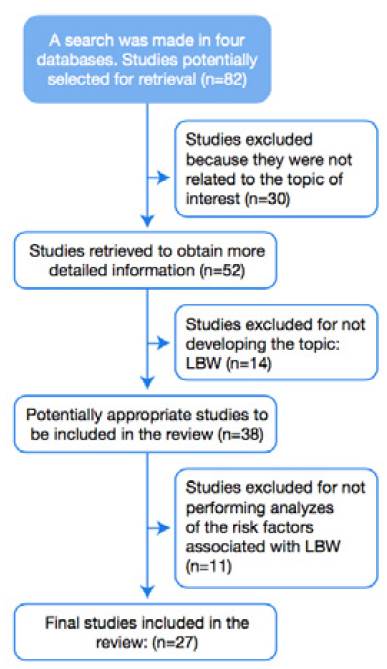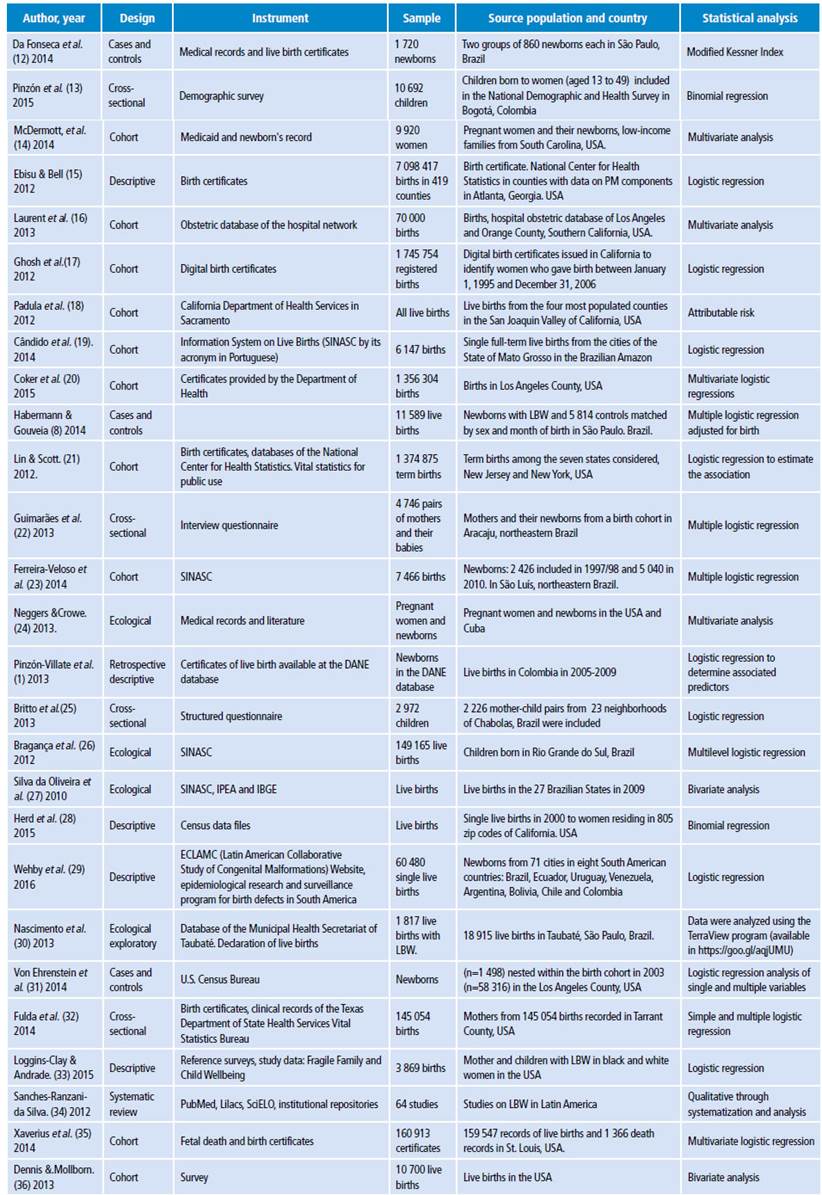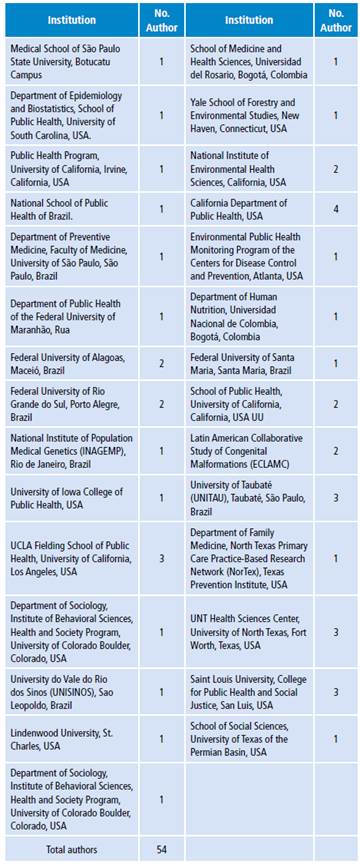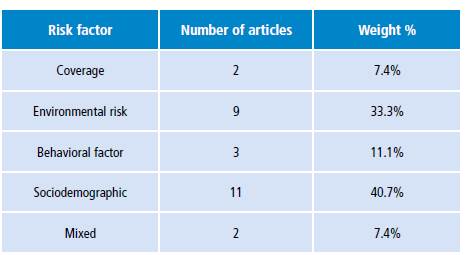Introduction
Research on sexual and reproductive health in Latin America is increasingly numerous in topics such as health interventions for the prevention of maternal and neonatal morbidity and mortality, specifically, those that study the increase and decrease of fertility, the use of different birth control methods, the quality of prenatal care and the prevalence of institutional delivery in rural and urban areas in certain populations and samples. All these investigations show that women are vulnerable according to their socioeconomic or educational level, employment conditions and family configuration. 1
The World Health Organization (WHO) considers that a newborn has low birth weight (LBW) if weight is below 2 500 grams, regardless of gestational age or any other etiology. 2 Children with LBW have 40 to 200 times greater risk of dying than children with adequate weight at birth. 3,4 In the Americas, a comparison can be made between the Latin American countries that have a LBW index of 8.6% and the United States, whose index is 0.5%. 5 Colombia is not the country with the highest LBW rate in Latin America, but it reached an index close to 8.5% in 2008. 1
It should be noted that the State of the World's Children 2008, published by UNICEF, reported that around 20 million children worldwide are born each year with LBW, a figure that corresponds to 14.5% of all live births. 5,6 Furthermore, UNICEF found that LBW is more prevalent in developing countries because they do not measure the weight of more than half of newborns. 7
In Colombia, the National Survey of Demography and Health (ENDS by its acronym in Spanish), conducted in 2010, reported that vulnerability to LBW is differential according to the place of occurrence of the births. For example, the risk is greater in departments like La Guajira, which do not achieve the national goal of reducing and meeting the Millennium Development Goals (MDGs). However, an improvement in the living conditions of the population and in social development opportunities was achieved 8, as deliveries took place in health facilities with a higher frequency: 88% in 2000, 92% in 2005 and 95% in 2010. 9,10 In consequence, conducting a narrative literature review on LBW in the Americas region during this decade is highly relevant.
Materials and methods
A narrative review of publications in health sciences about risk factors associated with LBW in the Americas was conducted. The research stages were: bibliographic search, data systematization, selection of articles and primary analysis, evaluation and final analysis.
During the first stage, information was collected from metasearch engines and digital databases including PubMed, SciELO, LILACS, VHL Regional Portal using DeCS (Descriptors in Health Sciences), MeSH (Medical Subject Headings) and Tripdatabase descriptors. Connectors "and" and "or", among others, were used. Likewise, a direct bibliographical search was carried out in multiple chapters of specialized texts as a complementary activity. The search was delimited as follows:
Time frame: 2010-2016.
Languages: English, Spanish and Portuguese.
Type of design: empirical studies without design limitations.
Document type: articles derived from research and review; therefore, gray literature, editorials, papers, communications and opinion articles were excluded.
Upon searching the databases, potentially selected studies were obtained and a total of 82 were retrieved. Titles, abstracts and full texts were independently examined, using the eligibility criteria specified, excluding 44 that did not have any relation to the subject of interest. Also, 11 articles were excluded because they did not deal with risk factors associated with LBW. Finally, 27 article type documents 11 were obtained as shown in Figure 1.

Source: Own elaboration based on the data obtained in the study.
Figure 1 Flow diagram of the study. Selection process of the studies.
Once the search was completed, the second stage of information systematization was carried out, during which matrices that contained objectives, author, country, methodology and results were elaborated. These matrices would facilitate the third phase: bibliometric and methodological extraction and analysis of geographical location, year, language, designs used, service evaluated, selection of the sample and statistical analysis of the information. The fourth stage consisted of defining the articles to be included considering full-text retrieval and their consistency with the objective of the review.
Results
Of the selected studies (Tables 1 and 2), 88% were published between 2012 and 2015 (Table 3). The country with the highest number of publications is the United States with 12 (44.4%), followed by Brazil with eight (29.6%). Regarding language, most articles were published in English with 15 (51.72%), followed by Portuguese with eight (29.6%).
Table 1 Methodology used by the studies found.

SINASC: Information System on Live Births; ECLAMC: Latin-American collaborative study of congenital malformations; PM: Particulate Matter; IPEA: Institute of Applied Economic Research; IBGE: Brazilian Institute of Geography and Statistics.
Source: Own elaboration based on the data obtained in the study.
Table 2 Institutions represented and number of authors.

Source: Own elaboration based on the data obtained in the study.
Table 3 Number of studies published per year included in the review.

Source: Own elaboration based on the data obtained in the study.
Regarding the results, Table 4 shows that 11 of the 27 published articles (40.7%) dealt with sociodemographic factors, 9 (33.3%) with environmental risks, 3 (11.1%) with behavioral factors, 2 (7.4 %) with prenatal or coverage controls and 2 (7.4%) correlated to other risk factors.
Table 4 Classification of articles by risk factors.

Source: Own elaboration based on the data obtained in the study.
It is noteworthy that nine articles (33.3%) conducted between 2011 and 2015 study the environmental risk related to LBW 21, for example, the association of water soluble metals such as copper and LBW. 37 An important finding in the United States is found in four counties of Connecticut and Massachusetts that reported the association of LBW with levels higher than 2.5PM of components such as aluminum, coal, nickel, silicon, vanadium and zinc. 38 These findings on risk factors in water reported that the probability of LBW is higher in Afro-descendant infants and mothers compared to white women. 15,20
The increase of LBW and air pollution are associated, 16,19 as is the case of benzene in contaminated air which, in addition to contributing to LBW, can cause fetal growth restriction and complications during pregnancy. 17 Prenatal exposure to air pollution is related to habitats or workplaces near high traffic congestion areas such as highways, whose traffic increases pollutants. 18,39 Finally, the presence of arsenic in the soil near housing areas is associated with LBW as well 14.
Several studies report relevant information regarding sociodemographic risk factors. An ecological study carried out in the state of Rio Grande do Sul in Brazil established that mothers who have had less than seven prenatal checkups have 3.8 times the risk of LBW. 34 This finding has been reported in the medical literature for decades, where sociodemographic, ethnic, maternal, fetal and environmental conditions were already correlated to LBW. 40
In this way, sociodemographic aspects and the health system itself are part of the specificities of prenatal care as a prevention strategy against LBW. However, in developing countries, it is often underestimated to such an extent that guidelines and strategies established in industrialized countries are used without hesitation. 13,12 Another sociodemographic risk factor refers to maternal age as a predisposing factor, since LBW as an outcome is higher in mothers older than 35 and under 20 years of age. 34,41 Likewise, mothers with low levels of education have a higher risk of LBW. 26
Studies that seek statistical significance between ethnic groups in the Americas and LBW 42,28 show an association with LBW prevalence in women of African descent. 29 According to a study in Caucasian and Hispanic couples with African American parents, paternal origin is an important predictor of LBW. 33 Although LBW is etiologically multifactorial, race is taken as a causal variable. 31,32,35
Similarly, low socioeconomic status and poverty take on greater relevance in research in South American countries. 22,43 Many of them consider health as the most precarious socioeconomic condition. 44 LBW is a condition influenced by many factors: He et al.45 report that its incidence depends on the pregnant woman's occupation during pregnancy; Camacho 46 states that medical risks in pregnancy such as cesarean delivery increase its probability; Rodríguez-Dominguez et al.41 point that congenital anomalies increase the risk of LBW more than three times; Neggers & Crowe 24 express that anemia increases its occurrence, and Britto et al.25 state that the mother's gain or loss of weight may also have an influence.
Modifiable lifestyles, such as smoking during pregnancy, have been reported as behavioral risks that trigger a series of complications that lead to LBW. 23 However, abstinence syndrome leads to sudden infant death or fetal growth restriction. 37,47
Finally, Silva de Oliveira et al.27 state that regional inequalities in living conditions, especially in access to maternal and child health, contribute to the unequal distribution of neonatal mortality.
Conclusion
The aim of this review was to summarize the most relevant findings on risk factors associated with LBW in the Americas, despite the fact that eight "best-match" publications on LBW since 2012 48-55 were not developed in this region. Although many of these countries met the goal of reducing the LBW by more than 95%, risk factors continue to be studied. The truth is that in Latin America there are countries that continue to maintain the incidence of LBW within the regional average due to deficient maternal nutrition, low socioeconomic status and associated maternal diseases. 56
It is worth mentioning that one of the limitations to this study was the restriction to access to all indicators and databases. Therefore, selection and systematization depended on access to the database of the Fundación Universitaria del Area Andina (Andean Region University Foundation).
Regarding the multifactorial etiology of LBW, it has been reported that most of the selected studies have agreed, for years, in the association of sociodemographic, biological and behavioral factors. In addition, the studies that refer association of LBW with environmental risk factors, particularly during maternity, carried out between 2012 and 2016, are increasingly gaining importance. The most intriguing findings in the United States include exposure to microparticles in water and soil near the oil zones of California and Texas, and exposure to air pollutants in cities like New York.
In Latin America, it is striking to see that the Amazon region has been under research, since this area is subject to enormous extractive and polluting activities. This changes the target of public policies to reduce LBW and improve the conditions of pregnant women and children in the Americas region, especially in less developed countries and territories where abandonment, social inequalities and environmental exploitation activities are becoming more frequent.














